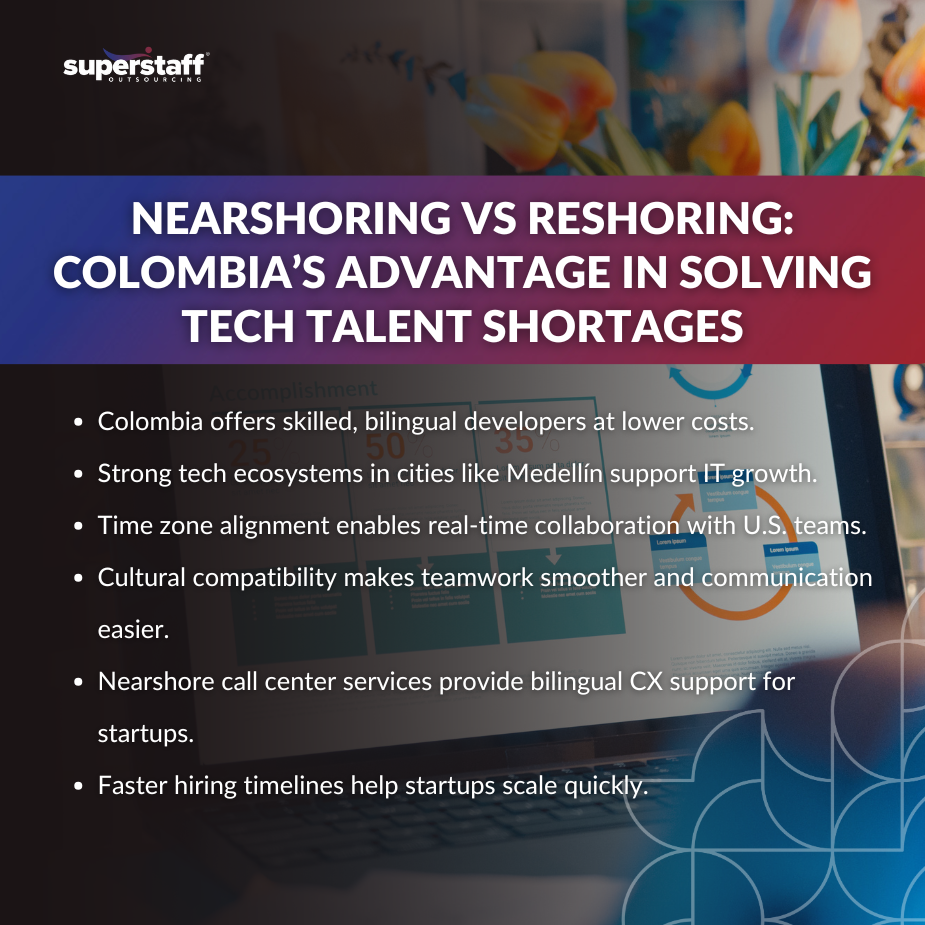
The global tech talent shortage has forced startups to rethink how and where they build their teams. With demand for skilled developers far outpacing supply in the U.S., many young companies are searching for smarter strategies to stay competitive without stalling innovation.
Two of the most talked-about solutions are nearshoring vs reshoring. Both approaches aim to help startups secure top-tier engineers and developers while navigating cost pressures and rising competition for talent. Yet, while they share the same goal, they present very different paths to achieving it.
In this blog, we’ll break down the strengths and weaknesses of each model and explain why startups must carefully evaluate which option best fits their long-term vision. More importantly, we’ll help founders and leaders understand the smarter way to overcome talent shortages and build sustainable growth in today’s fast-changing tech landscape.
The Talent Shortage Crisis Is Reshaping How Startups Scale
The tech industry is experiencing one of the worst talent shortages in decades. For startups, the crisis is especially acute. Unlike tech giants with deep pockets, startups must compete in the same talent pool but with fewer resources.
Rising demand meets shrinking supply
U.S. labor market data consistently shows that demand for software developers, data engineers, and cybersecurity professionals outpaces supply. The Bureau of Labor Statistics projects that software development jobs will grow 25% this decade, far faster than the average occupation. Yet universities and training programs aren’t producing enough graduates to meet this need.
Competition with larger tech companies
Startups often find themselves outbid for top talent. Companies like Google, Amazon, and Microsoft offer not only higher salaries but also perks, stock options, and global brand recognition. For small companies, competing in this environment is unsustainable.
The role of remote-first and global work trends
The pandemic normalized remote work, opening doors to international collaboration. Now, startups can consider global hiring strategies without worrying about whether clients or investors will accept distributed teams. The stigma around outsourcing has faded, replaced with recognition that global teams are critical to survival.
Why domestic hiring is no longer enough
Even if startups could afford U.S.-based developers, the numbers simply don’t add up. Limited talent pools and longer hiring timelines slow growth. To keep pace with innovation, startups must look beyond borders.
This pressure has fueled interest in workforce strategies like nearshoring vs reshoring for tech startup talent acquisition, each promising to solve the shortage in different ways.

What Reshoring Really Offers Startups—And Its Limitations
Reshoring means bringing operations and jobs back to the U.S. The approach has gained momentum as political leaders promote domestic job creation and as companies seek to regain control over fragmented supply chains.
The perceived advantages of reshoring
For startups, reshoring offers a few clear benefits:
- Proximity to headquarters: Teams working in the same country can collaborate more easily in person when needed.
- Cultural alignment: U.S.-based employees understand the market, language, and cultural nuances of American customers.
- Job creation optics: Investors and customers may see reshoring as a commitment to strengthening the local economy.
The challenges of reshoring
But these advantages come with significant drawbacks:
- High labor costs: U.S. tech talent commands some of the highest salaries in the world. For startups operating with tight budgets, this can eat into runway and slow scaling.
- Limited supply of skilled workers: Even with reshoring, the U.S. still faces a severe tech talent shortage. Bringing jobs back home doesn’t solve the problem of scarcity.
- Slower scalability: Hiring domestically often takes months, delaying product launches or pivots critical to startup success.
The hidden cost of reshoring for startups
While reshoring may work for large corporations with resources to absorb higher costs, it is less practical for startups. Investors expect fast scaling and capital efficiency—two things reshoring struggles to deliver.
For startups prioritizing agility and access to a wider pool of developers, nearshoring vs reshoring tech startups tips in favor of nearshore solutions.
Nearshoring—Bridging Time Zones While Tapping Global Talent
Nearshoring offers a middle ground between reshoring and offshoring. Instead of bringing jobs back to the U.S. or sending them halfway around the world, startups partner with teams in nearby countries, often in Latin America.
The advantages of nearshoring for startups
- Cost savings: Countries like Colombia offer highly skilled developers and engineers at a fraction of U.S. salaries, enabling startups to stretch budgets further.
- Bilingual talent: Many professionals in Colombia, Mexico, and Costa Rica are fluent in both English and Spanish, making communication seamless.
- Cultural compatibility: Latin America shares many cultural and business similarities with the U.S., easing collaboration and client-facing interactions.
- Real-time collaboration: Unlike offshoring to Asia, nearshoring allows U.S. startups to work in overlapping time zones, ensuring agile communication and faster turnaround.
Strong ecosystems in Latin America
Cities like Medellín, often dubbed the “Silicon Valley of Latin America,” are building robust tech ecosystems. Government investment in education, innovation districts, and startup incubators has created fertile ground for tech talent. This means U.S. startups not only gain access to skilled individuals but also tap into entire ecosystems supporting growth.
Time zone alignment as a competitive advantage
For agile startups, speed matters. Whether launching an MVP or pivoting in response to customer feedback, having a team available during U.S. business hours is invaluable. This makes nearshoring vs reshoring for tech startup talent acquisition especially compelling, since nearshore teams combine global affordability with local accessibility.
But when compared directly, how do nearshoring and reshoring stack up?
Nearshoring vs. Reshoring—A Direct Comparison for Tech Startups
Each approach offers unique benefits depending on startup priorities. But side-by-side comparisons reveal why many startups view nearshoring as the smarter choice.
Cost efficiency
Reshoring means hiring U.S.-based developers at salaries ranging from $100,000 to $180,000 annually. In contrast, nearshoring allows startups to access equally skilled developers for 40–60% less. For startups with limited venture funding, cost savings can mean the difference between launching a product or stalling.
Talent scalability
Reshoring is limited by the U.S. labor shortage. Nearshoring, however, opens access to a much broader pool of engineers and developers across Latin America. The scalability factor makes nearshoring essential for startups looking to expand quickly.
Speed of hiring and project delivery
Nearshore teams are typically ready to scale faster, with outsourcing providers offering pre-vetted pools of talent. Reshoring requires startups to engage in lengthy recruitment processes, slowing down innovation cycles.
Long-term strategy
Reshoring may appeal to companies that prioritize national optics or government incentives. But for startups whose survival depends on agility and cost-efficiency, nearshoring provides a stronger long-term growth engine.
Beyond the numbers, the real question for startups is which strategy fuels innovation and creates lasting competitive advantage.
Choosing the Smarter Way Forward—Why Startups Lean Nearshore
Startups live and die by their ability to innovate quickly and scale efficiently. In this environment, nearshoring consistently proves the smarter choice.
Nearshoring as the middle ground
Nearshoring offers the best of both worlds—greater proximity than offshoring with lower costs than reshoring. It enables startups to scale without sacrificing collaboration or quality.
Success stories from U.S. startups
Many U.S. startups already rely on nearshoring to Colombia and other Latin American hubs. By building distributed teams, they accelerate development cycles, reduce costs, and focus internal resources on core innovation.
The role of nearshore call center services
Beyond IT development, startups are also leveraging nearshore call center services to handle customer support. With bilingual agents working in real-time U.S. hours, these services improve customer experience while freeing startups to focus on scaling products.
Strategic BPO partnerships
BPO providers play a vital role in ensuring startups can tap into high-quality talent pipelines. By partnering with firms experienced in nearshoring vs reshoring for tech startup talent acquisition, startups gain not only workers but also infrastructure, compliance, and management support.
With the right nearshore partner, startups can turn today’s talent shortages into tomorrow’s growth opportunities.
Still Torn Between Nearshoring vs Reshoring? Find Your Ideal Outsourcing Strategy With SuperStaff
Both nearshoring and reshoring are responses to the tech talent shortage, but one offers a more practical path for startups.
Reshoring provides proximity and cultural alignment but struggles with high costs and limited supply. Nearshoring, by contrast, offers cost savings, scalability, and time zone alignment—critical advantages for resource-constrained startups.
At SuperStaff, we help startups build high-performing nearshore teams in Colombia and beyond. From IT development to nearshore call center services, we deliver the right blend of cost savings, collaboration, and innovation. If you’re weighing nearshoring vs reshoring, let us show you why nearshoring is the smarter way to scale.






